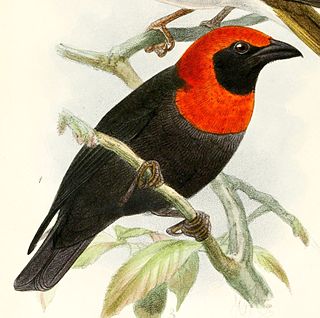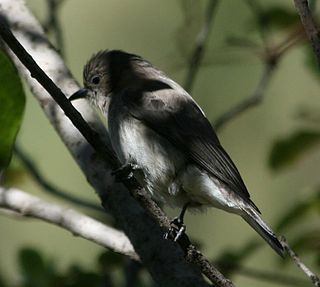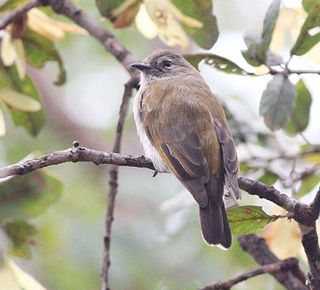
Honeyguides are near passerine birds in the order Piciformes. They are also known as indicator birds, or honey birds, although the latter term is also used more narrowly to refer to species of the genus Prodotiscus. They have an Old World tropical distribution, with the greatest number of species in Africa and two in Asia. These birds are best known for their interaction with humans. Honeyguides are noted and named for one or two species that will deliberately lead humans directly to bee colonies, so that they can feast on the grubs and beeswax that are left behind.

Cassin's finch is a bird in the finch family, Fringillidae. This species and the other "American rosefinches" are placed in the genus Haemorhous.

Cassin's auklet is a small, chunky seabird that ranges widely in the North Pacific. It is the only species placed in the genus Ptychoramphus. It nests in small burrows and because of its presence on well studied islands in British Columbia and off California it is one of the better known auks. It is named for the American ornithologist John Cassin.

Williamson's sapsucker is a medium-sized woodpecker belonging to the genus Sphyrapicus (sapsuckers).

Cassin's kingbird is a large tyrant flycatcher native to western North America. The name of this bird commemorates the American ornithologist John Cassin.

The white-throated bush chat, also known as Hodgson's bushchat, is an Old World flycatcher in the genus Saxicola. It is IUCN Red Listed as Vulnerable by BirdLife International. In 2001, the global population has been estimated at between 3,500 and 15,000 individuals. The major threat appears to be the rapid loss of grasslands in its wintering areas. It winters in the Nepal and Indian Terai and in the Dooars. In this region, it has been recorded in Jim Corbett, Shuklaphanta, Chitwan, Kaziranga, and Manas National Parks and in Lumbini Crane Sanctuary. It prefers wet and dry grasslands, reeds and tamarisks along riverbeds, and also occurs in sugarcane fields. In spring and summer, it breeds in the alpine or sub-alpine meadows and scrub in the mountains of Mongolia and adjacent parts of Russia.

Cassin's vireo is a small North American songbird, ranging from southern British Columbia in Canada through the western coastal states of the United States. This bird migrates, spending the winter from southern Arizona to southern Mexico.

The scaly spurfowl is a species of bird in the family Phasianidae. It is found in Angola, Burundi, Cameroon, Central African Republic, Republic of the Congo, Democratic Republic of the Congo, Equatorial Guinea, Ethiopia, Gabon, Kenya, Malawi, Nigeria, Rwanda, São Tomé and Príncipe, Sudan, Tanzania, and Uganda.

The feline owlet-nightjar is a species of bird in the family Aegothelidae. It is found in New Guinea. Its natural habitat is subtropical or tropical moist montane forests.

The African dwarf kingfisher is a species of kingfisher in the Alcedininae subfamily.

The orange-crowned fairywren is a species of passerine bird in the Australasian wren family, Maluridae. It is monotypic within the genus Clytomyias. It is found on New Guinea in its natural habitat of subtropical or tropical moist montane forests.

Cassin's malimbe is a species of bird in the family Ploceidae. It is found in Cameroon, Central African Republic, Republic of the Congo, Democratic Republic of the Congo, Equatorial Guinea, Gabon, and Ghana.

Cassin's flycatcher, also known as Cassin's grey flycatcher or Cassin's alseonax, is a species of bird in the family Muscicapidae. It is found in Angola, Benin, Cameroon, Central African Republic, Republic of the Congo, Democratic Republic of the Congo, Ivory Coast, Equatorial Guinea, Gabon, Ghana, Guinea, Liberia, Niger, Nigeria, Rwanda, Sierra Leone, Togo, Uganda, and Zambia. Its natural habitat is subtropical or tropical swamps.

The brown-capped weaver is a species of bird in the family Ploceidae. It is found in Angola, Burundi, Cameroon, Republic of the Congo, Democratic Republic of the Congo, Equatorial Guinea, Kenya, Nigeria, Rwanda, South Sudan, Tanzania, and Uganda.

The white-browed jungle flycatcher, also known as the Luzon jungle-flycatcher and the Rusty-flanked jungle-flycatcher, is a species of bird in the Old World flycatcher family Muscicapidae. It is endemic to Luzon island, in the Philippines. The natural habitat of the white-browed jungle flycatcher is tropical moist montane forests. It is threatened by habitat loss.

The streak-backed antshrike is a species of bird in the family Thamnophilidae. It is found in Venezuela and adjacent parts of Guyana and northern Brazil.

The blue-headed crested flycatcher is a species of bird in the family Monarchidae, native to the African tropical forest.

The brown-backed honeybird, also known as Wahlberg's honeybird, Wahlberg's honeyguide and sharp-billed honeyguide, is a species of bird in the family Indicatoridae. This bird is named after the Swedish naturalist Johan August Wahlberg.

The green-backed honeybird, also known as the eastern green-backed honeyguide, green-backed honeyguide and slender-billed honeyguide, is a species of bird in the family Indicatoridae.





















